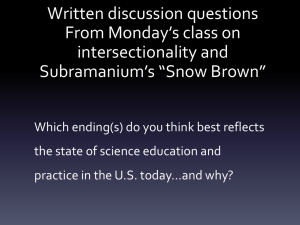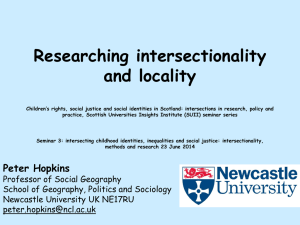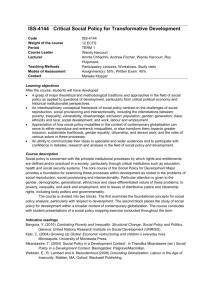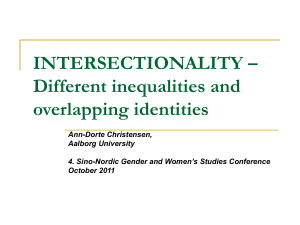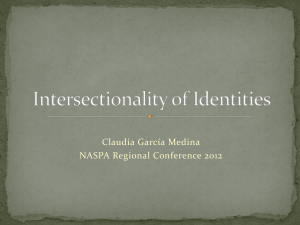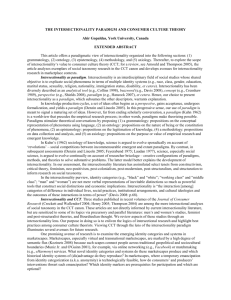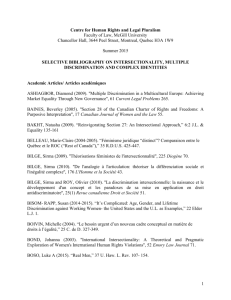- IOE EPrints - Institute of Education, University of
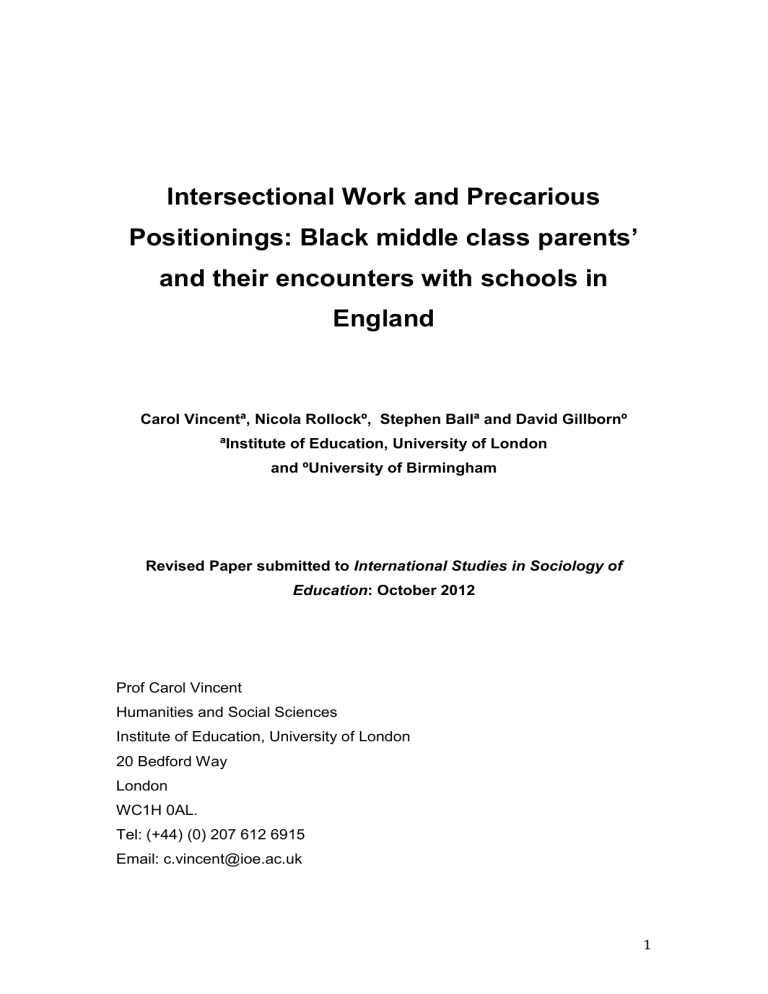
Intersectional Work and Precarious
Positionings: Black middle class parents’ and their encounters with schools in
England
Carol Vincent ª, Nicola Rollockº, Stephen Ballª and David Gillbornº
ªInstitute of Education, University of London and ºUniversity of Birmingham
Revised Paper submitted to International Studies in Sociology of
Education: October 2012
Prof Carol Vincent
Humanities and Social Sciences
Institute of Education, University of London
20 Bedford Way
London
WC1H 0AL.
Tel: (+44) (0) 207 612 6915
Email: c.vincent@ioe.ac.uk
1
Biographical notes
Carol Vincent is a Professor of Education at the Institute of Education,
University of London. Her research interests include parents’ relationships with the education system, social class, and education policy. She was the
Principal Investigator of the research project presented here.
Nicola Rollock lectures at University of Birmingham. Her research interests include race equality and wider social justice issues within education, and links between policy and practice. She is the lead author on a forthcoming book on education and the Black middle classes.
Stephen Ball is the Karl Mannheim Professor of Sociology of Education at the
Institute of Education, University of London. His main areas of interest are contemporary education policy and equity. His latest book is Global Education
Inc: New Policy Networks and the Neoliberal Imaginery, (2012), published by
Routledge.
David Gillborn is Professor of Critical Race Studies at the University of
Birmingham. His work includes research on racism in schools and conceptual writing on the nature of racism in educational policy and practice. He is founding editor of the international scholarly journal Race Ethnicity and
Education .
Correspondence to : Carol Vincent, Institute of Education, University of
London. c.vincent@ioe.ac.uk
2
Intersectional Work and Precarious Positionings: Black middle class parents’ and their encounters with schools in England
Abstract
This paper reports on data drawn from a study exploring the educational strategies of 62 Black Caribbean-heritage middle class parents. In this paper we consider the respective roles of race and class in the shaping of parents’ educational strategies, deploying an analysis that focuses on their intersection, and seeks to hold both race and class in productive tension. Drawing on empirical data, we illustrate how parents ’ classed and raced identities shape their interactions with school staff.
Key words : Black parents, school, intersectionality, social class, race
3
Intersectional Work and Precarious Positionings: Black middle class parents’ and their encounters with schools in England
Patricia Hill-Collins recalls a day when, as a sixteen-year-old, attending a movie theatre, she witnessed a young White usher violently remove two Black children. When she went to complain she found several Black adults already informing the manager of the incident:
Ignoring them, the manager turned to his teenaged employee and asked him what had happened. Red-faced and stammering, the usher denied hurting the boys and, if that were not enough, claimed that he had seen the boys sneak into the theatre. After hearing his employee’s testimony, the manager turned back to the adults. “You must have been mistaken,” he flatly stated. He turned his back on all of us and simply walked away.
(...) On that day I learned that, in some situations, gender, age, social class, and education do not matter if you are Black. The usher and the movie theatre manager could see only race and their perceptions of race clouded their judgment (2006: 2)
Introduction: Parents and schools - class and race
In this extract, Hill-Collins vividly illustrates how class and other resources that are held by Black people can be negated by racism. The event she describes takes place in the early 1970s in the US. In a different time (the present) and location (England), our research project explores the intersection of class and race, and how these two social dimensions shape Black Middle cla ss parents’ strategies for and interventions around their children’s education. The majority of the research on parental interactions with the education system in general (through choice of school for example) or with particular institutions has been with White middle class parents, or if with an ethnically mixed respondent group, then ethnicity has not been the primary focus (see Archer 2010, Crozier & Davies 2007, Weekes-Bernard 2007,
Reynolds 2005, for exceptions). We seek to address this by focusing on respondents’ educational strategies as they seek to navigate their children
4
successfully through the education system, exploring how in this particular historical moment, this location, and this field (education), class and race intersect and shape parental strategies. In the first section we identify some key points in current discussions around intersectionality. We then introduce the study, and illustrate the way in which parents ’ strategies around education are shaped by both their racialised and classed identities. We conclude by emphasising that although many of the parents’ strategies are proving successful in guiding their children through the education system, they demand considerable labour as they draw on all available resources. This labour can be thought of as intersectional work, that is, working on and at the intersections of race and class.
Race or class?
In considering the respective roles and relationships of race and class in the constitution of identity as a Black middle class parent and the consequent shaping of educational strategies, writing on intersectionality theory has proved helpful. In a seminal paper, Crenshaw (1993) emphasised that identities are not reducible to just one dimension; that a theoretical focus on, say, class can simplify and reduce, and through reduction, miss and misrepresent the experiences of, for example, Black working class women, and the inter-related roles of class, race and gender in their lives. In contrast, intersectionality theory seeks to understand the complexity of social identity by focusing on gender, class, race, ethnicity, disability, and sexual orientation
– ‘the great axes of social differentiation’ (Bilge 2010: 58) to which we might also add age and religion, and ‘postulat[ing] their interplay in the production and reproduction of social i nequalities’ (Bilge 2010: 58). Brah and Phoenix provide a general definition. Intersectionality, they say,
Signif [ies] the complex, irreducible, varied and variable effects which ensue when multiple axis of differentiation – economic, political, cultural, psychic, subjective and experiential – intersect in historically specific contexts (Brah & Phoenix, 2004: 76)
Intersectionality theory is, then, centred on the understanding that individuals
5
do not occupy a ‘single, easily stated, unitary identity’ (Delgado & Stefancic
2001: 9). Intersectionality encapsulates the notion of multiple identities, and the intersection of race and class can be said to be characterized by a particularly complex form of double consciousness: what Du Bois has described as ‘this sense of always looking at one’s self through the eyes of others, of measuring one’s soul by the tape of a world that looks on in amused contempt and pity,’ (Du Bois 1989:5). An intersectional perspective has the potential to address the conceptual and policy ‘separateness’, bell hooks notes, between race and class, a separateness that results in the absence of an ‘on-going collective public discourse’ that puts race, class and gender
‘together in ways that illuminate for everyone how our nation is organised,’
(hooks 2000: 8) 1 .
Intersectionality emphasises fluidity, and the importance of different locales, situations, spaces, times, different dispositions and subjectivities, for understanding particular interactions and identities. All identities can be conceived of as made up of intersectional dimensions, although the focus has more often been on marginality, rather than privilege (Nash 2008). As we are particularly focusing on the Black middle classes, we seek through our research to study the interaction of privilege and disadvantage, and agree with Nash that intersectionality theory should also address the way in which dimensions o f identity interact to ‘secur[e] both privilege and oppression’
(2008 p.10).
Since the Crenshaw paper cited above, the writing on intersectionality has grown markedly in a range of disciplines. Our aim here is to briefly indicate three of the issues raised in this literature, which seem most pertinent to our analysis of our project data. The first issue is an identified lack of specificity and precision of intersectionality as a theory. Sometimes work on intersectionality can seem frustratingly ambiguous and ambivalent. Olesky
1
Gender is extremely important in this project, for example we will be writing about the differential positioning of Black boys and girls by both their teachers and parents. Additionally as already noted, the majority of our respon dents were women. The way in which the apparently neutral ‘parent’ and
‘parenting’ comes to mean, in practice, ‘mother’ and ‘mothering’ has been discussed elsewhere (e.g.
Vincent 2010). However in this paper the focus is on the interaction of class and race.
6
(2011 p.265) questions whether intersectionality’s plurality is a strength or a weakness. The criticism has been made that intersectionality is too incomplete, too general a theory – what Davis has called ‘inherently hazy and mystify ingly open ended’ (Davis, 2008 p.69) – to offer any analytical depth. In a similar vein, Nash refers to intersectionality’s ‘contradictions, absences and murkiness’ (2008 p.3).
The second issue is contention around the conceptualizion of relationships between different dimensions of inequality. Bilge notes that a hierarchical or cumulative approach to oppression is generally rejected by the intersectionality literature, but the broadly held position – that race, gender and class are ‘mutually constitutive’ does not ‘always project any ontological or epistemological light on what “mutually constitutive”’ means (2010 p.63). It is this issue that we are exploring empirically in our research, aiming to shed some light on the forms of ‘mutual constitution’ of race and class which shape both Black middle class parents
’ thinking and activity around education.
Academics such as Yuval Davis (2006), Acker (2006) and Walby (2007) are amongst those who strongly argue for retaining in analysis, the specificity of the particular ontologies and histories of race, class and gender (Bilge 2010 p.
64). Indeed, Acker (2006) proposes a focus on ‘gendered and racialized class practices’, with class providing her ‘entry point’ into ‘complex ongoing practices’, an analytic approach she defends on the basis that gender and race-based discrimination in the United States (and the UK) are illegal.
A lthough she notes that ‘white privilege and male privilege’ remain ‘ubiquitous’, she argues that ‘class based inequalities in monetary reward and in control over resources, power and authority […] are accepted as natural and necessary for the on-going function of the socioeconomic system’ (Acker
2006 p.52).
Acker also acknowledges that hers is just one possible approach to understanding the operation of intersecting power relations, and that gender or race could equally well be an ‘entry point’. This identification of an ‘entry point’ seems to us crucial, as we agree with Flintoff et al (2008 p.80) (citing
Archer, Hutchings & Leathwood 2001) that the drawing of
‘provisional
7
boundaries’ around particular social groups is itself an act of power. Preston &
Bhopal (2012) take up this point, as they discuss their commitment to
‘foregrounding’ race within their analysis. In contrast to Acker, they call for the space to ‘”speak” to ‘race’ alone’ and ‘address its primacy when necessary’
(p.215), arguing that in the academy, focusing on gender or class is considered ‘respectable’, but ‘to think about ‘race’ as a primary social relation is considered to be a project which is at best essentialist, and at worst nationalist, even racist’ (p.214).
We reproduce these arguments, as by suggesting that one dimension of inequality should be given a degree of primacy, they illustrates the difficulties of our project; of holding both class and race in productive tension, trying to understand the workings of both, and their points of interdependence for particular social groups and individuals, in particular situations. The wording which Preston and Bhopal (2012) use - ‘its primacy when necessary’ (our emphasis) does speak to the way in which intersectionality focuses on the fluid, rather than fixed, understandings of the interaction of different social dimensions.
With regard to the third issue
– a debate around identifying particular levels of analysis -
Winker & Degele (2011) call for ‘multi-level work’ that requires an analysis that moves between i) individual identity and the range of categories that can constitute that (e.g. Black Caribbean heterosexual female); ii) symbolic hegemonic representations of particular groups and behaviours (in relation to our project, the way in which Black boys may be positioned as disruptive and threatening), and iii) structural power relations, (i.e. concrete relations of power in particular social fields; in relation to our work, the many sites in which Black people are marginalised).
We have tried to respond to these three issues through the use of what Bilge refers to as ‘mediatory concepts around which intersectionality can become operational’ (2010 p.69). In relation to our own research, which primarily attends to the way in which parents view and interact with schools and strategize about education, we have adopted two such concepts, drawn from
8
the different frameworks offered by Bourdieu and Critical Race Theory (CRT).
In relation to our first framework, w e draw on various aspects of Bourdieu’s work, but particularly his concept of capital, its deployment, and his emphasis on the social inequalities relating to differential possession and accumulation of forms and volumes of capital (see Vincent et al 2012). Bourdieu argues that social class is not simply ‘a collection of occupations, but [is] primarily based around different kinds of capital’ (Savage et al 1992 p.16; Bourdieu 1998), and he draws our attention to ‘the structure of distribution of the forms of power or the kinds of capital which are effective in the social universe under consideration – and which vary according to the specific place and moment at hand ’ (Bourdieu 1998 p.32).
In relation to our second conceptual resource, following various CRT theorists
(e.g. Ladson-Billings 1998, Delgado & Stefancic 2001, for overview see
Gillborn 2008), we start from the position that race is socially constructed and that which is traditionally defined as ‘racial difference’ is invented, perpetuated and reinforced through a myriad of social structures, actions and assumptions that operate in the interests of White people. Drawing on the insights of CRT, we ‘foreground the experiences and voices of people of colour. In particular, we build on the CRT tenet that scholarship should accord a central place to the experiential knowledge of people of colour as a means of better understanding and combating race inequity in education (Gillborn et al 2012;
Gillborn 2008).
These mediatory concepts provide us with analytical resources in order to examine the ways in which race and class differently intersect for the respondents in different situations, and serve to position them in varying ways.
Through their deployment we aim to sharpen, deepen and focus our analysis.
Over the project as a whole, we hope this approach will strengthen the specificity and precision of our analysis (in response to the first of our identified concerns with intersectionality), whilst retaining as distinctive the substantive categories of race and class (Preston & Bhopal 2012) (in partial response to issue two), and to move analytically between different micro and macro levels (in response to issue three). Below, we illustrate our approach by operationali zing these ‘mediatory concepts’, considering the ways in which
9
and the extent to which the respondents succeeded in deploying their particular forms and volumes of capital in defence of their interests and those of their children in a society pervaded by White privilege. Thus our work seeks to explore the intersections of race and class without the automatic conceptual or empirical privileging of one. We seek to explore not whether class or race is more or less influential in the organisation of children’s lives, but to explore the differences and commonalities of Black parents ’ experiences, and to consider how race and class interact in particular situations and interactions. We wish to focus on the work Black parents do at points of intersection; that is to explore both the possibilities and limitations of such intersectional work at points where structure confronts agency.
Before we turn to the data, it may be necessary to note that although we focus primarily on race and class, we recognize the importance of other dimensions of identity, gender of course, but also sexuality, disability, and religion.
Judging by the demands of some writers - see for instance Holvino (2010 p.266) who calls for a perspective
‘that analyses race, gender, ethnicity, class, nationality and sexuality as simultaneous processes of identity [practice], institutional [practice] and social practice
’ - we might be deemed to be falling short by focusing on one particular intersection, that of race and class. Such a focus can be defended however by its particular relevance to our group of respondents. They were very aware of being part of an emerging and relatively small group in the UK – the Black middle class - and the contradictions, struggles, and privileges of that particular social position are the ones we set out to analyse.
The study
Our data is drawn from 77 qualitative semi-structured interviews with 62 parents who self-define as Black Caribbean. Participants were recruited through a range of sources that included their responding to announcements on family and education websites, Black professional networks and social
10
groups 2 as well as through extensive use of snow-balling via existing contacts within the professional Black community. Participants were selected following completion of a brief filter questionnaire that asked about their ethnic group identification (we were focusing on individuals who identified as Black
Caribbean); the age of their children and for information about their occupation.
We were interested in speaking with those parents with at least one child between 8 and 18 years, age groups that encompass key transistion points in their school careers. With regard to class categorisation, we sought parents, sometimes referrred to as the ‘service class’ (Goldthorpe 1995) , in professional or managerial occupations (i.e. NS-SEC 1 and 2) using the
Standard Occupational Classfication manuals. As is common in research on
‘parents’, most of our respondents are mothers. However, sensitive to debates about the role of Black men as fathers, 13 of our participants are fathers. The respondents were very enthusiastic about the research and we had no difficulty recruiting our sample. Interviews were carried out in London and elsewhere in England, and we returned to 15 of our 62 respondents in order to conduct follow-up interviews (giving us 77 interviews in total). These second interviews allowed us to ask additional questions on themes which arose from our analysis of the initial interviews, but which were not part of our original research schedule (e.g. we asked whether and in what ways respondents talked with their children about racism), or to revisit original themes in more depth (e.g. the complex relationship between race and class in the formation of identity).
It is impossible to be sure of the effects of ethnic symmetry/asymmetry on the process of interviewing, and we plan to devote a paper to this complex issue.
Briefly, we note here that our team consisted of one Black member and three
White members. Interviewees were given the opportunity to express a preference for an interviewer of the same ethnic background; 14
(23%) explicitly stated that they preferred to be seen by Dr Rollock, the team member of Black Caribbean heritage. Respondents frequently appeared to identify with Dr Rollock, by for example, referring to her positioning as one of
2 For example: the Family & Parenting Institute e-newsletter; the GTCE e-newsletter; Black solicitors network; 100 Black Men of London e-newsletter.
11
a small minority of Black academics, or
‘switching codes’ (e.g. using Patois) at points in the conversation. It would be a mistake, however, to view the
‘outsider’ position of the rest of the team as uniformly problematic. For example, respondents often fully explained experiences and interactions, knowing that they would be outside the personal experience of the White team member (see also Hendrix 2002, Ochieng 2010, Rollock, 2012 for a further discussion). There were also other points of symmetry such as gender, age, and having similar aged children that different team members shared with respondents.
All interviews were audio recorded, transcribed and then coded across the team.
A combination of hand-coding and the use of NVivo was used to chart regularities in the data in relation to particular themes and to help in identifying both prevailing tendencies and discrepant cases (Lecompte and Preissle,
1993). Initial theoretical categories were drawn from existing literature, research and theory on race, class and education, and were refined and challenged using the constant comparative method. Ethical issues have been a subject of intense concern amongst the team. We are, of course, acutely aware of the sometimes dishonourable history of research undertaken by
White researchers which has offered pathological representations of Black communities. Such portrayals arose from a research focus on the perceived differences, inadequacies and exoticisms of Black people rather than a focus on White racism, and this we have tried to avoid. We continue to be aware of the impossibilities of stepping away from our raced, classed and gendered identities, and we remain sensitive to the way in which we view the world through these lenses.
Being Black and middle class: strategies for recognition
Our analysis leads us to argue that the basis for the engagement of Black middle class mothers and fathers, with the school system, their orientation towards it, lies on radically different ground to that of White middle class parents. There is, however, some commonality in terms of strategy (see also
Lareau 2003, Archer 2010) as both White and Black middle class parents perceive schooling to be a risk. A risk, that is, that children may not fully
12
realise their academic potential. Middle class parents do not generally maintain an unquestioning trust in the education system (especially the state education system), rather displaying what Vincent et al (2002) have referred to as a restricted or ‘managed trust’. The perception of ‘risk’ for Black middle class parents is pervaded by their awareness of, and often their own experiences of, racism and low expectations of their ability when children (see
Gillborn et al 2012 for more details). Therefore the parents in our study, although they have individual concerns, share an urgent need to manage similar risks to their children, and as we illustrate below, they draw on their particular resources of social, cultural and economic capital in order to do so.
The parents are marshalling those resources against the ‘symbolic violence’
(Bourdieu and Passeron 1977) of the education system, which deems, for example, Black children’s cultural knowledge inferior. Indeed, it could be ar gued that the potential ‘violence’ to the life chances of the children, to their educational and labour market opportunities, and to their well-being and self esteem are solid and not merely symbolic. Data on exclusion rates, achievement levels and access to high status universities (see e.g. Wright
2012, Gillborn 2008, Strand 2007, Tomlinson 2005, Shiner & Modood 2002 ) are all documented indicators of jeopardy. Several parents spoke of high levels of educational achievement as offering their children choices in later life, and the space and agency with which to define themselves. White parents may express similar priorities, but Black parents had a more urgent rationale.
Strong educational credentials were understood as offering their children the best chance of success in a UK higher education sector where Black students are under represented at prestigious universities (see e.g. Vasagar 2010) and a labour market, in which discrimination based on race remains a significant factor (EHRC 2010). Strategies to minimize risk encompass investments both out of school (such as encouraging achievements in extra-curricular areas, see Vincent et al forthcoming, and ensuring that children had a strong self image), and within school. The latter involved defending themselves and their children against misrecognition, by deploying resources to position themselves as assertive but reasonable advocates for their children, and their children as good and responsible learners. This is the area on which we concentrate here, highlighting, in particular, parents’ ‘conversational’
13
approaches to teachers, and their awareness of the risks inherent in naming racism.
Defending against misrecognition
The parent-respondents noted that in the majority of cases, they and their children faced not crude and overt racism (although that had by no means disappeared), but subtle yet pervasive , ‘mundane’ racism; that is, degrees of misrepresentation and mis-recognition of both parent and child which could be highly insidious in their effects.
Cynthia describes how her interactions with teachers at a state primary school convinced her that for the W hite teachers’ ‘ there was only a certain level of achievement that my boy as a Black Ch ild could achieve’ . She felt she could not trust the system to educate her children to ‘ t heir true and fullest capacity’ , and as a result suspended her teaching career to home-school her three young children. This strategy illustrates the complex interplay of race and class. It is driven by her determination to avoid her sons being positioned at a particular nexus of race and gender, as deficit, despite their class background.
Additionally, giving up her paid work leads to financial sacrifices, and is ultimately made possible by her husband’s professional salary. She speaks of the importance of giving her children a ‘grounding’ in Black history and cultures to ensure their confidence, and a strong, proud self-image.
They need to know about the influence Black people have on this country, they’re not aliens in this country, they have right to be here, they are a part of society…we’re not an appendage […] They come from greatness… [My message to them is] we expect you to be great, we expect you to achiev e…there’s no mediocrity..I will not allow my boys to be mediocre because too much has gone on, too much blood was shed for them to be just, whatever, boys walking with pants down your backside.
(Cynthia, teacher)
Misrepresentation was also an issue in relation to teacher assumptions concerning parents themselves. Black women felt they were facing
14
caricatured, and racist assumptions that they lack knowledge, sophistication, and calm.
Sometimes people categorise you, they expect you to be whatever stereotypical kind of screeching, not able to articulate, black female
(Cassandra, Director of training company),
Class – and supposed working class deficiencies – are also visible here.
Several mothers spoke of the assumption that they were lone mothers, and fathers spoke of being perceived as a potential physical threat; subject positions at particular structural intersections of race, class and gender
(Lareau 2003 notes the same assumptions impacting on Black fathers).
Similarly, in the USA, Cooper cites African American mothers in her research as being seen as ‘irrational, threatening and combative’ in their interactions with schools, (2007: 492). Parents in our study responded to these stereotypes, by deploying class-based resources, forms of social and cultural capital, to seek to escape particular intersectional positionings.
And you find it helpful sometimes to use your status, what job you do. And people treat you differently. I don’t necessarily want to say
I do x, y and z, but I found that if you don’t sometimes say that, they treat you in a way, my own experience as a Black woman
– oh, you’re a single parent – there is a category they read off as to who you are without really knowing anything about you (Eleanor, social worker )
I think I’m seen because I’m the kind of parent that does go into school… knowing what my rights are and having read up on subjects, I think that the staff in the school find me difficult. And that is to do with class and its expectations…..Along with being uncomfortable about this is a middle class Black woman. They are not used to dealing with that [laughs] and if I were a middle class
W hite woman they’d find it easier. I just don’t meet their expectations (Lorraine, researcher, voluntary sector)
15
Whilst professional status and particular forms of cultural capital (knowledge about the education system for example) are helpful, they can serve, as
Lorraine notes, to increase the amount of labour Black parents have to do, as they work against and around W hite school staff’s discomfort. As Valentine notes (2007) ‘when individual identities are ‘done’ differently in particular temporal moments, they rub up against and so expose the dominant spatial ordering that defines who is in place/out of place, who belongs and who does not’ (2007 p.19). In this sense, our respondents were often treated as being
‘out of place’ since being Black, in the UK, is commonly read as being working class. We discuss the requirement laid on Black people to manage their public identity in order to avoid and pre-empt racist mis-readings in some detail elsewhere (Rollock et al 2011, see also Lacy 2007).
Deploying capitals
Parents’ classed resources can be thought of in terms of Bourdieu’s forms of capital. This is not the place to discuss Bourdieu’s work in detail as it has been debated exhaustively elsewhere. Briefly therefore, we will note that every individual has a ‘portfolio’ of economic, social and cultural capital
(Crossley 2008). Clearly not all individuals have access to capitals that are equally valued and valuable in particular social fields. Lareau (2008) makes the further point that possession of capital does not necessarily mean that an individual can realize a social advantage from those resources. Elsewhere
(Vincent et al 2012) and below we discuss how White power holders can interrupt a process of activation of resources by denying validity and legitimacy to Black parents’ capitals. Such a scenario illustrates Bourdieu’s point that social fields are the settings for competition over positions of advantage, and also highlights the utility of a CRT perspective, that identifies the taken-for-granted centrality of White assumptions of what counts as valued capital.
In relation to interactions with school specifically, parents spoke of being highly attuned to the image they presented through their dress and their voice
(accent and vocabulary in particular), they frequently referred to the
16
importance of speaking ‘properly’ and being articulate, being polite, but assertive. They displayed their knowledge of the education system, spoke with confidence and assurance, but within a ‘conversational’ mode (Vincent &
Martin 2002), designed to engineer a dialogue of equals. As noted above, stereotypical depictions of Black parents position them as un-interested parents, or as parents who, when they do engage, are confrontational and antagonistic. However, we found just one account of ‘storming’ (incidents of overtly confrontational protest, see Vincent & Martin 2002, Ranson et al 2004) within 77 transcripts, and this was where the parents, present in school in response to their child’s reports of unfair and harsh discipline on the part of a teacher, witnessed such treatment. Barbara describes the common conversational approach taken by parents in this research.
My partner says very nicely, ‘I just wanted to draw your attention to…’ you know. So you have to do it kind of strategically, but it’s a fact of life really (Barbara, health professional)
Below, we discuss how parents deploy their class resources as a form of resistance. They refuse to be positioned as unknowing, unworthy and uncaring by educational institutions and careless or callous individuals who are suffused with unexamined and unrecognized White privilege. Parents commonly referred to ways in which they felt they had to use their class resources to signal to White majority institutions the respectability and worthiness of themselves and their children. Femi describes investing in a particularly visible form of ‘good’ mothering, to combat racial stereotypes. This is working at the intersections of class, race and gender; intersectional identity work, in other words.
I won’t let my daughter go to school unless everything is ironed, her shoes are polished [..] T here’s no way she’s looking scruffy because I will not let people make that judgment about her…That if you’re Black, you’re working class, you’re scruffy, you don’t care and that’s all you ever can be […] There is a real pressure there to make sure that everything in [her lunchbox] is healthy and just right..It’s not just that it’s
17
got to be right and appropriate, it’s got to be seen to be appropriate [..]
The [school has] a rul e about no crisps…and jam sandwiches or whatever, so we make sure that she’s got three different kinds of sandwiches that’s on brown bread [laughs] she has fruit, everything, you know. There’s nothing anybody can critique on it, nothing. I know she won’t eat half of it…
(Femi, Further Education (FE) lecturer)
Here capitals are being mobilized and deployed to assemble a particular social and maternal body, the responsible mother. Children’s food and eating is indeed the site of public concern, leading to the explicit labeling of foods as
‘bad’ or ‘good’ (for overview see Evans et al 2010). In response, children’s food, especially public displays such as a lunchbox, has become one example of a ‘morality tale’ told and performed by middle class mothers (Liechty 2003 p.69), part of a production of a ‘class-cultural space’ (ibid p.256). For Femi, her classed perception of the need to visibly be a responsible and respectable mother, intersects with her sense that, because of her race, she is especially vulnerable to being labelled as irresponsible and disreputable. Femi’s reference to her daughter’s appearance is interesting. Several parents spoke of the importance they placed on being smartly dressed in public situations.
Moore notes that ‘grooming is a long-time strategy of racial resistance and an important component of demonstrating morality and respectability within the
Black community’ (2008 p.497).
Going beyond appearance to learning behaviour, Malorie argues for the importance of ‘making up’ a good learner, sending children to school with a good ‘script’ which, to some extent will act to position the child favourably and protect them from uninformed and unknowing teacher prejudice.
So you send your young people in there with a good attitude, good aspiration s, good ambitions, but if they [the children] haven’t got someone sending them in with that script, and they come up against teachers, some of them coming from the Outer Hebrides, and have never seen a[n ethnically] mixed community, you know, they are losing out on all fronts (Malorie, local government)
18
There are two points to make here. One is that the attributes Malorie identifies are to do with presentation as well as substance
– the ability and willingness to pr esent as a ‘good’ (i.e. enthusiastic, able, relatively compliant) learner with high aspirations and ambition. Malorie perceives a need for Black children to explicitly perform these intrinsic characteristics and qualities. It is a presentation that is bolstered by access to middle class resources. The other point to make is that class resources will only protect the children to some degree, as Malorie goes on to note. They will not necessarily prevent racist occurrences, but may change how children and adults handle these.
Similarly Cassandra speaks of deploying her class resources to alter or preempt racist stereotyping.
Class is about having a professional standing, having a certain level of awareness and understanding of your place in the world and how you can impact on things around you, and so I think that class and being a
Black middle class women has occasionally allowed me to translate, transcend being a Black woman (Cassandra)
She describes ‘gently’ prompting her daughter’s headteacher to introduce more multi-ethnic books in school.
They changed all the books. It was awesome really. This is perhaps another example where class and race can merge..I did not go in there as you know ‘we are Black people and you should not have this and that and the other’. [Rather] ‘it is a little bit dated and it would be really good ..if the children could have resources that would reflect their experiences’. Well [coming from] Black parents who work in business and medicine, whatever, [the headteacher] took it on board.
Cassandra suggests that her reasoning, non-threatening style, avoiding explicit mentions of race and racism, backedup by her and her husband’s professional status improved the chances of her voice being heard. This is a
19
successful strategy and in the new books, she receives the result she is looking for. However to describe her demeanor as simply a strategy, a ploy, a form of performance, would be to downplay the embodied dispositions and capitals that form her identity, her investment in particular classed forms of respectability and ‘appropriate’ behavior (Skeggs 2004). Other modes of interaction in which Cassandra engages – such as the use of Patois – are vulnerable to negative (White) judgment, and so are reserved for relatively private settings.
Ella takes a similar reflective and considered approach. After several incidents, she begins to question the validity of the reprimands issued to her son by staff at his private school.
So I had to work with the head of the middle school to alert her to the fact that this was going on and she was very sensible. I found she was very sensible in her approach. I didn’t have to spell out too obviously what my concerns were. I think she was very able to read between the lines. […] Some of the playground assistants [pause] it was a training issue and yeah they’ve got a difficult job to do, trying to watch so many children, and I think sometimes they went for the easy option of not always finding out what actually happened ..If you’re not careful some children could receive a label or a tag which they would have to struggle to shake off..We just kept a very close eye on it and made sure the appropriate people were aware […].
By positioning the adults’ behavior towards her son as due to a lack of training,
Ella goes to some lengths in this interview not to name racism. Indeed in her second interview with [name of team member], she makes it clear that this is a conscious strategy.
I have never actually been in a situation where I have gone out and said
‘you are racist’ or ‘I think this is an act of racism’. It is something I am very reluctant to do because you get (claps her hands) shut down….I would very much approach that I am going to go and deal with this
20
situation. I am going to try and sort out this situation with you because I think once you mention to people you think they have been racist, they clam up. But what you can say is that
‘this behaviour is a problem…how can we tackle it and turn it round?
’
Ella’s fears of a ‘shutdown’ at the mention of racism mirrored the experience of another mother, Felicia, whose son had been subject to crude and overt racism at his private school. Her naming of racism had so frightened or angered the school that the headteacher responded by inaction and a refusal to discuss the issues. Only after Felicia took her son out of school did the headteacher respond – by blaming her son for the racism he had experienced
(see Vincent et al 2012 for more details). Felicia’s plentiful supply of capitals were denied legitimacy by the school who simply refused to engage with her concerns. Rachel’s young son also experienced exclusionary incidents at his
(different) prestigious private school, and Rachel also attempted to take up this and other instances of racial prejudice as a matter of school policy. This school was also unwilling to discuss these issues. Like Felicia, Rachel took her child out of school, and she moved him into another, less prestigious, private school. Interestingly, she sees her son’s experiences at the first school as stemming from a mixture of class and racial prejudices. Her son was the wrong colour, and also belonged to the wrong fraction of the middle classes.
I think it was very much a class thing..The people …who go to that particular school are very sort of, they would call themselves upper middle class, they are very snooty and they have got really strong, preconceived ideas about Black people [..] They don’t know any Black people, they don’t mix with Black people in their social circles and you can see it in their children. [Son] was just not included in things in the way I think he should have been (Rachel, solicitor)
At his new school, with its more ethnically diverse intake, from ‘normal middle income families’ her son has ‘slotted in’ and is happy. Like Felicia, Rachel was prevented from activating her class resources by the school simply stonewalling in the face of her explicit naming of race and racism. Additionally,
21
perhaps, her class resources, despite her successful professional background, were also judged insufficient and devalued in this elite context.
Concluding thoughts
We have sought here to illustrate the complex ways in which race and class are ‘mutually constitutive’ (Bilge 2010 p.63), how they intersect in shaping parents’ educational strategies, some of which we have identified here.
Intersectionality theory encourages us to consider the fluid and context specific ways in which race and class combine to ‘make up’, to constitute the identities, priorities, values, and actions of the participants in our study.
However, we also want to root our analysis in the ‘specific ontologies of each set of social relations’ (Bilge 2010 p.68), (class and race in this case), and using CRT and Bourdieu as ‘mediatory concepts around which intersection ality can become operational’ (Bilge 2010 p.69) allows us to do this.
Developing an analysis that works with both bodies of work
– Bourdieu and
CRT - and that holds multiple and precarious positionings in tension, is, to say the least, challenging, and di fferent team members have different ‘takes’ on where the analytical emphasis should lie at particular points. Class resources, may be so deeply embodied – the ‘silent player’ (Dewan 2012 p. 113) - that they pass largely unremarked; that is, that our social and cultural resources appear simply as part of our personalities, our demeanors, determining the
‘right’ and ‘natural’ actions to take in particular situations. By contrast, the respondents are reminded every day that they are members of a racial minority. As Catherine notes, her racial identity is given primacy by herself and others.
I’m used to defining myself as Black every single day, even when I don’t open my mouth, and I’m Black first and foremost […] It’s very rare that I have to define myself by social class (Catherine, headteacher).
Thus it is perhaps unsurprising that, broadly speaking, the parent-respondents argue that for them ‘ race trumps class’ (Femi) in most situations.
22
We have attempted to illustrate here the way in which parents carry out what can be thought of as intersectional work, drawing on the range of resources available to them. We have shown how the respondents in our project invest time and energy in the development of their children as successful learners.
They work to defend their children and themselves from racism, stereotyping, and seemingly entrenched low expectations. In order to resist misrepresentations of themselves and their children, based on damaging, negative, and stereotypical perceptions of Black working class behaviour and attitudes, parents deployed a range of social, cultural and economic resources.
Both positive and negative readings are possible here. Through their strategizing, their intersectional work, their labour, there is the potential for paren ts’ ‘strategies of action’ (Moore 2008) to lead to the ‘remaking of racial meaning in day to day life’ (Craig 2002, p.9, cited in Moore 2008 p.499), as they present purposeful, knowledgeable and engaged parental identities to counter the dominant White stereotypes of Black parents as lacking in these attributes. However, the degree and extent of the labour required by Black parents in their interactions with schools and the uncertainty of success (see also Valentine 2007 p.19), speaks to the continuing significance of race and racism, despite the advantages of their class position, in shaping their and their children’s experiences as they strive for educational success.
23
References
Acker, J. (2006) Class Questions: feminist answers Lanham, Maryland,
Rowman & Littlefield.
Archer, L., Hutchings, M. & Leathwood, C. (2001) Engaging in commonality and difference, International Journal of Sociology of Education 11: 41
–62.
Archer, L. (2010) "We raised it with the Head": The educational practices of minority ethnic, middle-class families, British Journal of Sociology of
Education 31, 4: 449-469
Ball, S. (2003) Class Strategies and the Education Market Place . London,
RoutledgeFalmer.
Bilge, S. (2010) Recent feminist outlooks on intersectionality, Diogenes, 57, 1:
58-72.
Bourdieu, P. (1998) Practical Reason . Cambridge, Polity Press.
Bourdieu, P. (1997) The forms of capital, in Halsey, A, et al (eds.) Education,
Culture, Economy, Society.
Oxford, OUP
Bourdieu, P. & Passeron, J. (1977) Reproduction in Education, Society and
Culture . London, Sage.
Brah
, A. & Phoenix, A. (2004) Ain’t I a woman? Revisiting Intersectionality.
Journal of International Women’s Studies
. 5, 3: 75-86
Cooper, C. (2007) School choice as ‘motherwork’: valuing African-American women’s educational advocacy and resistance,
International Journal of
Qualitative Studies in Education , 20, 5: 491-512.
Crenshaw K. (1993) Mapping the margins: intersectionality, identity politics and violence against women of color Stanford Law Review 43: 1241-
Crossley, N. (2008) Social class, in Grenfell, M. (ed.) Pierre Bourdieu, Key
Concepts, Stocksfield, Acumen Press.
Crozier, G. & Davis J., (2007) Hard to reach parents or hard to reach schools?
A discussion of home-school relations, with particular reference to
Bangladeshi and Pakistani parents, British Educational Research Journal , 33,
3: 295-313.
Davis, K. (2008) Intersectionality as buzzword, Feminist Theory 9, 1: 67-85.
Delgardo, R. & Stefancic, J. (2001) An Introduction to Critical Race Theory .
New York, New York University Press.
24
Dewan, I. (2011) Race Slash Class: Mixed heritage youth in a London school in K. Bhopal & J. Preston, (eds). Intersectionality and Race in Education.
London, Routledge.
Du Bois, W.E.B. (1989) The Souls of Black Folk.
London: Penguin
Equality & Human Rights Commission (2010) How Fair is Britain? Equality,
Human Rights and Good relations in 2010: The First Triennial Review .
London: EHRC.
Evans, C. et al (2010) SMART lunch box intervention to improve the food and nutrient content of children's packed lunches: UK wide cluster randomised controlled trial, Journal of Epidemology and Community Health , 64: 970-976
Flintoff, A., Fitzgerald H. & Scraton, S. (2008): The challenges of intersectionality: researching difference in physical education , International
Studies in Sociology of Education , 18:2, 73-85
Gillborn, D. (2008) Racism and Education: Co-incidence or Conspiracy?
London, Routledge.
Gillborn, D. et al. (2012
) ‘You got a pass, so what more do you want?’: Race, class and gender intersections in the educational experiences of the Black middle class, Race Ethnicity and Education 15, 1: 121-139.
Hendrix, K. (2002) "Did being Black introduce bias into your study?":
Attempting to mute the race-related research of Black scholars Howard
Journal of Communication , 13, 2: 153-171 hooks, b. (2000) where we stand: class matters . New York and London:
Routledge
Hill-Collins, P. (1991). Black feminist thought: Knowledge, consciousness and the politics of empowerment . New York: Routledge
Hill-Collins, P. (2006), Black Sexual Politics: African Americans, Gender, and the New Racism . New York, Routledge,
Holvino, E. (2010) Intersections: The simultaneity of race, gender and class in organization studies, Gender, Work & Organization 17, 3: 248-277.
Kingston, P. (2001) The unfilled promise of cultural capital, Sociology of
Education 74: 88-99
Ladson-Billings, G. (1998) Just w hat is Critical Race Theory and what’s it doing in a nice field like education? International Journal of Qualitative Studies in Education , 11, 1: 7-24.
25
Lareau A. (2003) Unequal Childhoods Berkley, University of California Press
Lareau, A. (2008) Watching, waiting and deciding when to intervene: race, class and the transmission of advantage, in L. Weis (ed.) The Way Class
Works: readings on school, family, and the economy. New York, Taylor &
Francis.
LeCompte, M. & Preissle, J. (1993) Ethnography and Qualitative Design in
Educational Research. San Diego, Academic Press .
Leonardo, Z. & Porter, K. (2010) Pedagogy of fear, Race Ethnicity Education
13, 2: 139-157.
Liechty, M. (2003) Suitably Modern: Making middle class culture in a new consumer society , Princeton, Princeton University Press.
Maylor, U. & Williams, K. (2011) Challenges in theorising ‘Black middle class’ women: education, experience and authenticity Gender & Education 23, 3:
345-356.
Moore, K. (2008) Class formations: Competing forms of black middle-class identity, Ethnicities , 8, 492-517
Nash J. (2008) Rethinking intersectionality Feminist Review (2008) 89, 1
–15.
Ochieng, B (201
0) “You know what I mean:” The ethical and methodological dilemmas and challenges for Black researchers interviewing Black families
Qualitative Health Research 20 12: 1725-1735
Oleksy, E. (2011) Intersectionality at the crossroads
Women’s Studies
International Forum 34, 4: 263-270.
Phoenix A. & Pattynama P. (2006) Editorial,
European Journal of Women’s
Studies , 13, 3: 187-192.
Preston, J. & Bhopal, K. (2012) Conclusion: Intersectional Theories and
‘Race’: From Toolkit to ‘Mash Up, in K. Bhopal & J. Preston, (eds).
Intersectionality and Race in Education.
London, Routledge.
Ranson, S., Martin, J., & Vincent, C. (2004) Storming Parents, schools and communicative action, British Journal of Sociology of Education, 25 (3): 259-
274.
Reynolds, T. (2005) Caribbean Mothers: Identity and experience in the UK.
Stoke, Trentham Press.
Rollock, N. (2012) The Invisibility of race: Intersectional reflections on the liminal space of alterity. Race Ethnicity & Education 15, 1: 65-84.
26
Rollock, N. et al (2011) The Public Identities of the Black Middle Classes:
Managing race in public spaces. Sociology 45, 6: 1078
– 1093
Savage, M., Barlow, J., Dickens, P., and Fielding, T. (1992 ) Property,
Bureaucracy and Culture . London, Routledge.
Shiner, M. & Modood T. (2002) Help or hindrance? HE and the route to ethnic equality, British Journal of Sociology of Education , 23, 2: 209-232.
Skeggs, B. (2004) Class, Self, Culture . London, Routledge.
Strand, S. (2007) Minority Ethnic Pupils in the Longitudinal Study of Young
People in England (LSYPE).
London, DCFS.
Tomlinson, S. (2005) Race ethnicity and education under New Labour, Oxford
Review of Education , 59, 1: 10-21
Valentine, G. (2007): Theorizing and researching intersectionality: A challenge for feminist geography , The Professional Geographer ,
Vasagar, J. (2010) Twenty-one Oxbridge colleges took no black students last year, The Guardian, Dec 6 th , http://www.guardian.co.uk/education/2010/dec/06/oxford-colleges-no-blackstudents
Vincent, C. & Martin, J. (2002) Class, culture and agency: researching parental voice, Discourse, 23, 1: 109-128
Vincent, C., Rollock, N., Ball, S. & Gillborn, D. (forthcoming) Raising Black middle class children: parenting priorities, strategies and actions. Sociology
Vincent, C., Rollock, N., Ball, S. & Gillborn, D. (2012) Being strategic, being strategic, being watchful, being determined: Black Middle Class parents and schooling, British Journal of Sociology of Education 33, 3: 337-354
Walby, S. (2007) Complexity theory, systems theory and multiple intersecting social inequalities, Philosophy of the Social Sciences 37, 4: 449-470.
Weekes-Bernard, D. (2007) School Choice and Ethnic Segregation.
London,
The Runnymede Trust.
Winker, G. & Degele, N., (2011) Intersectionality as multi-level analysis: dealing with social inequality European Journal of Women's Studies . 18, 1:
51-66.
Wright, O. (2012) Fewer jobs and lower pay: Black graduates pay price in jobs crisis as majority fail to find work, The Independent, 23 rd April, http://www.independent.co.uk/news/uk/politics/fewer-jobs-and-lower-pay-
27
black-graduates-pay-price-in-jobs-crisis-as-majority-fail-to-find-work-
7669134.html?origin=internalSearch (last accessed 17 th September 2012)
Yuval-Davis N. (2006) Intersectionality and feminist politics , European Journal of Women’s Studies
, 13, 3: 193-209.
28

